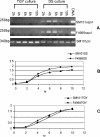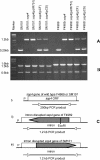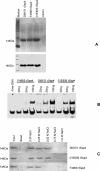A novel small acid soluble protein variant is important for spore resistance of most Clostridium perfringens food poisoning isolates
- PMID: 18451983
- PMCID: PMC2323104
- DOI: 10.1371/journal.ppat.1000056
A novel small acid soluble protein variant is important for spore resistance of most Clostridium perfringens food poisoning isolates
Abstract
Clostridium perfringens is a major cause of food poisoning (FP) in developed countries. C. perfringens isolates usually induce the gastrointestinal symptoms of this FP by producing an enterotoxin that is encoded by a chromosomal (cpe) gene. Those typical FP strains also produce spores that are extremely resistant to food preservation approaches such as heating and chemical preservatives. This resistance favors their survival and subsequent germination in improperly cooked, prepared, or stored foods. The current study identified a novel alpha/beta-type small acid soluble protein, now named Ssp4, and showed that sporulating cultures of FP isolates producing resistant spores consistently express a variant Ssp4 with an Asp substitution at residue 36. In contrast, Gly was detected at Ssp4 residue 36 in C. perfringens strains producing sensitive spores. Studies with isogenic mutants and complementing strains demonstrated the importance of the Asp 36 Ssp4 variant for the exceptional heat and sodium nitrite resistance of spores made by most FP strains carrying a chromosomal cpe gene. Electrophoretic mobility shift assays and DNA binding studies showed that Ssp4 variants with an Asp at residue 36 bind more efficiently and tightly to DNA than do Ssp4 variants with Gly at residue 36. Besides suggesting one possible mechanistic explanation for the highly resistant spore phenotype of most FP strains carrying a chromosomal cpe gene, these findings may facilitate eventual development of targeted strategies to increase killing of the resistant spores in foods. They also provide the first indication that SASP variants can be important contributors to intra-species (and perhaps inter-species) variations in bacterial spore resistance phenotypes. Finally, Ssp4 may contribute to spore resistance properties throughout the genus Clostridium since ssp4 genes also exist in the genomes of other clostridial species.
Conflict of interest statement
The authors have declared that no competing interests exist.
Figures






Similar articles
-
Further characterization of Clostridium perfringens small acid soluble protein-4 (Ssp4) properties and expression.PLoS One. 2009 Jul 17;4(7):e6249. doi: 10.1371/journal.pone.0006249. PLoS One. 2009. PMID: 19609432 Free PMC article.
-
Genotypic and phenotypic characterization of Clostridium perfringens isolates from Darmbrand cases in post-World War II Germany.Infect Immun. 2012 Dec;80(12):4354-63. doi: 10.1128/IAI.00818-12. Epub 2012 Oct 1. Infect Immun. 2012. PMID: 23027533 Free PMC article.
-
NanH Is Produced by Sporulating Cultures of Clostridium perfringens Type F Food Poisoning Strains and Enhances the Cytotoxicity of C. perfringens Enterotoxin.mSphere. 2021 Apr 28;6(2):e00176-21. doi: 10.1128/mSphere.00176-21. mSphere. 2021. PMID: 33910991 Free PMC article.
-
The biology and pathogenicity of Clostridium perfringens type F: a common human enteropathogen with a new(ish) name.Microbiol Mol Biol Rev. 2024 Sep 26;88(3):e0014023. doi: 10.1128/mmbr.00140-23. Epub 2024 Jun 12. Microbiol Mol Biol Rev. 2024. PMID: 38864615 Free PMC article. Review.
-
Enterotoxigenic Clostridium perfringens: detection and identification.Microbes Environ. 2012;27(4):343-9. doi: 10.1264/jsme2.me12002. Epub 2012 Apr 14. Microbes Environ. 2012. PMID: 22504431 Free PMC article. Review.
Cited by
-
Structural Changes in Trabecular Bone, Cortical Bone and Hyaline Cartilage as Well as Disturbances in Bone Metabolism and Mineralization in an Animal Model of Secondary Osteoporosis in Clostridium perfringens Infection.J Clin Med. 2021 Dec 30;11(1):205. doi: 10.3390/jcm11010205. J Clin Med. 2021. PMID: 35011946 Free PMC article.
-
Identification of novel Clostridium perfringens type E strains that carry an iota toxin plasmid with a functional enterotoxin gene.PLoS One. 2011;6(5):e20376. doi: 10.1371/journal.pone.0020376. Epub 2011 May 31. PLoS One. 2011. PMID: 21655254 Free PMC article.
-
Genetic Characterization of the Exceptionally High Heat Resistance of the Non-toxic Surrogate Clostridium sporogenes PA 3679.Front Microbiol. 2017 Apr 3;8:545. doi: 10.3389/fmicb.2017.00545. eCollection 2017. Front Microbiol. 2017. PMID: 28421047 Free PMC article.
-
Identification of a new Clostridium perfringens variant with a chromosomally encoded enterotoxin gene in a suspected persistent food poisoning outbreak in Eritrea.Front Microbiol. 2024 Oct 15;15:1459840. doi: 10.3389/fmicb.2024.1459840. eCollection 2024. Front Microbiol. 2024. PMID: 39529666 Free PMC article.
-
Clostridial Myonecrosis: A Comprehensive Review of Toxin Pathophysiology and Management Strategies.Microorganisms. 2024 Jul 18;12(7):1464. doi: 10.3390/microorganisms12071464. Microorganisms. 2024. PMID: 39065232 Free PMC article. Review.
References
-
- McClane BA. Clostridium perfringens. In: Doyle MP, Beuchat LR, editors. Food Microbiology Fundamentals and Frontiers. Washington (D.C.): ASM Press; 2007. pp. 423–444.
-
- Lynch M, Painter J, Woodruff R, Braden C. Surveillance for foodborne-disease outbreaks - United States, 1998–2002. Morbidity and Mortality Weekly Report, CDC. 2006;55:1–42. - PubMed
-
- Sarker MR, Carman RJ, McClane BA. Inactivation of the gene (cpe) encoding Clostridium perfringens enterotoxin eliminates the ability of two cpe-positive C. perfringens type A human gastrointestinal disease isolates to affect rabbit ileal loops. Molec Microbiol. 1999;33:946–958. - PubMed
-
- Cornillot E, Saint-Joanis B, Daube G, Katayama S, Granum PE, et al. The enterotoxin gene (cpe) of Clostridium perfringens can be chromosomal or plasmid-borne. Molec Microbiol. 1995;15:639–647. - PubMed
Publication types
MeSH terms
Substances
Grants and funding
LinkOut - more resources
Full Text Sources
Medical
Research Materials
Miscellaneous

